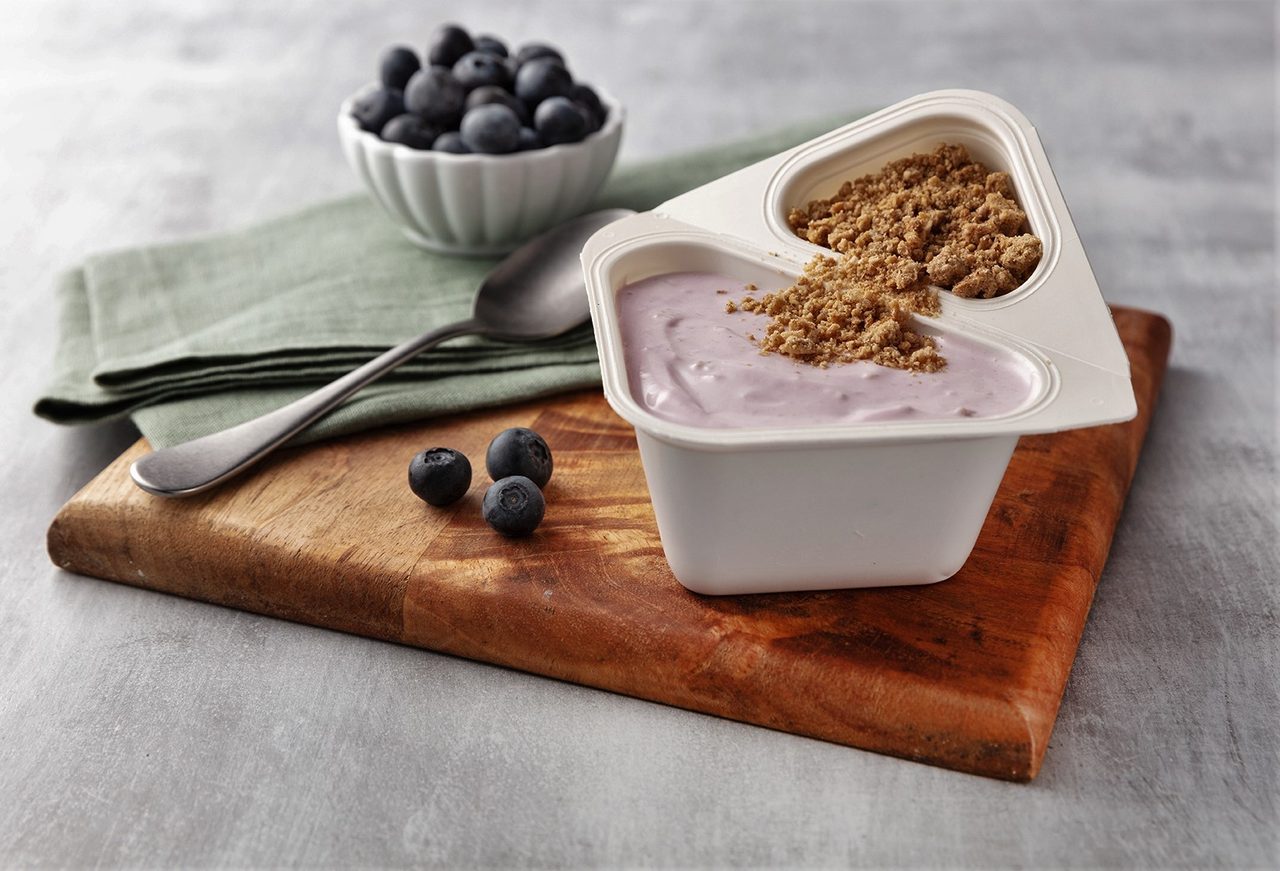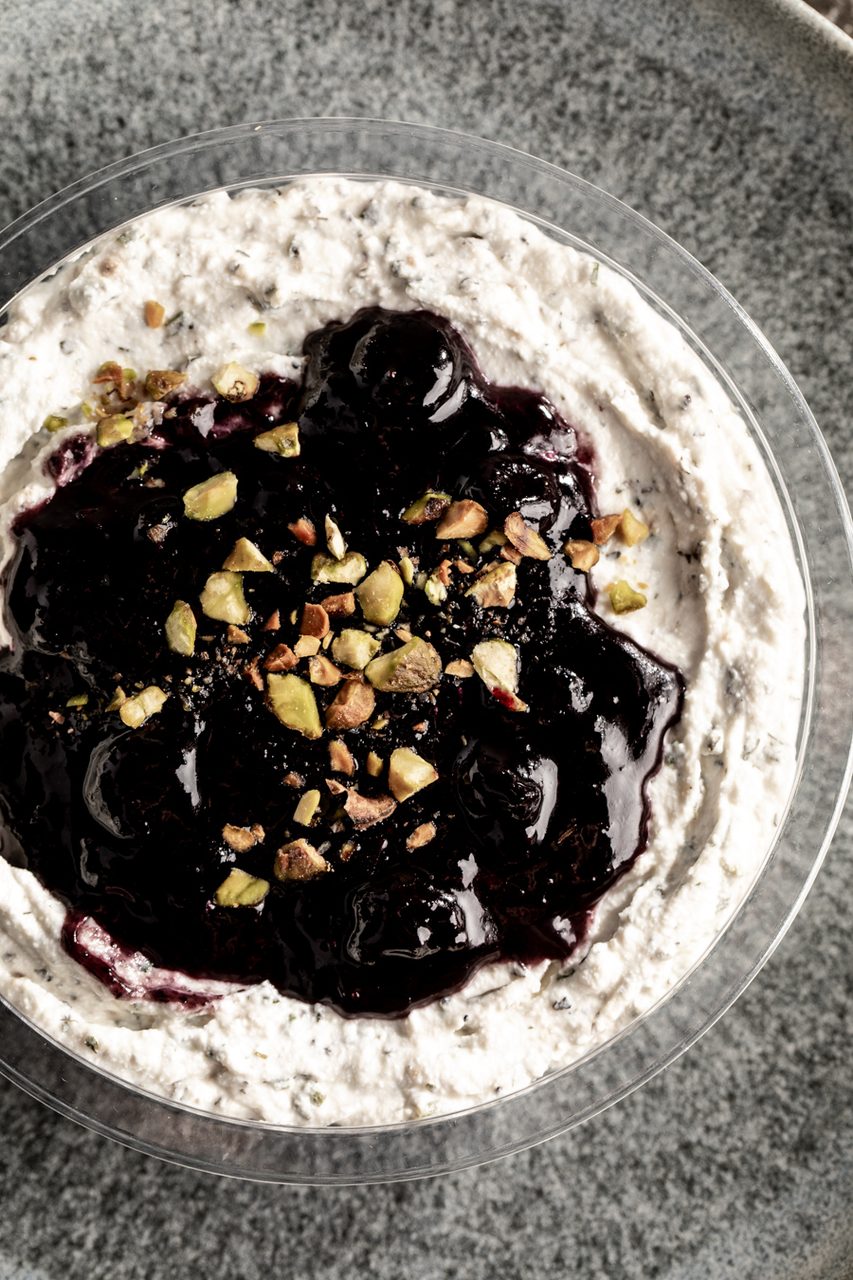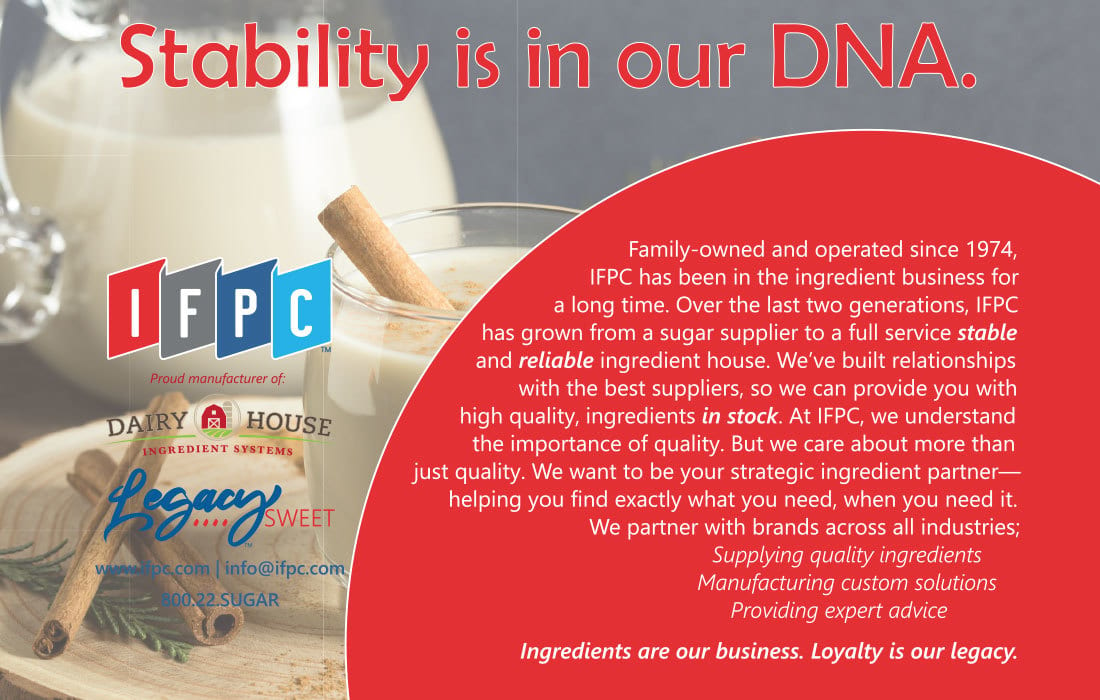More than extras
INGREDIENT
TECHNOLOGIES
Dairy processors can use inclusions to impart health benefits, jazz up flavor and create exciting textures.
By Anna Boisseau, managing editor
Photo courtesy of grandriver via gettyimages.com.
Dairy processors can use inclusions to impart health benefits, jazz up flavor and create exciting textures.
Inclusions — visible ingredients that add extra flavor, texture and color into a food or beverage product — have been used to jazz up dairy offerings for years. And such ingredients are set to register a 5.6% compound annual growth rate during 2021-2028, notes The Industry Partners in its "Food Inclusions Market to 2028 – Global Analysis and Forecast – by Type, Form and Application” report.
According to the New York-based market research firm, food and beverage manufacturers can use inclusions as a tool to add value or bring innovation into their existing product line, “as these ingredients can skip the step of formulating an entirely new product recipe.”
So as dairy processors seek to meet evolving consumer needs, they can look to their ingredient partners to develop interesting inclusions as a lower-risk way to create new products. Parker Food Group (PFG), for example, uses its research on four “macro trends” influencing the food and beverage industry when developing “on-trend flavor concepts” for the segments it services, explains John Pimpo, marketing director for the Fort Worth, Texas-based company.
These macro trends include “permissible indulgence, eating experience for the consumer, the informed consumer and lifestyle choices,” he says.
According to Corinne Kowald, product developer for Pecan Deluxe Candy Co., Dallas, processors also are paying attention to trends such as sugar reduction and increased protein when selecting inclusions.
“Consumer trends are constantly driving us to innovate,” she adds.
Photo courtesy of Pecan Deluxe Candy Co.

Add a health benefit
As the COVID-19 pandemic continues, consumers are more concerned with their health overall, and many look for foods with immunity-boosting claims. In response, processors are asking ingredient suppliers for healthier inclusions and/or those that offer functional benefits.
For example, processors are asking for more sugar-free inclusions than in the past, explains Kelsey Cheadle, application scientist, research and development for Kalamazoo, Mich.-based FlavorSum.
“This could be a response to how consumers have changed their diets because of COVID-19, with 30% of U.S. internet users identifying sugar [reduction] as more important to them due to the pandemic,” she says.
In its research, PFG characterizes better-for-you products under the “lifestyle choices” macro trend, Pimpo notes. He says that many people now shop for products that match their diet and lifestyle of choice — viewing food as fuel.
“Popular diets include low/no sugar, keto, paleo, general nutrition bars/foods, intermittent fasting, nondairy, vegan, flexitarian, intuitive eating [and] gluten-free,” he says.
In this space, PFG offers inclusions that contain no/low sugar and some that are fortified with protein, Pimpo shares. For example, PFG recently launched a line of high-protein cookies in Chocolate, Graham and Vanilla flavors. The inclusions are available as crushed or whole cookies and also as cookie gems; they offer 30 grams of protein per 100 grams.
“These cookies have been formulated to assist developers in fortifying their finished product with protein,” Pimpo emphasizes. “The high-protein cookies will be their own source of protein so the developer can focus more on flavor and performance of the product itself.”
Adding fruits or nuts into dairy products also can impart health benefits. Almonds, for example, offer additional protein and fiber, explains Charice Grace, manager, trade marketing and stewardship for the Modesto, Calif.-based Almond Board of California.
And blueberries also have a healthy reputation, says Alicia Adler, vice president, global business development for the U.S. Highbush Blueberry Council.
“They’re very much seen as functional boosters in packaged good products since their health halo has innate credibility in that space,” she points out.
The organizations that Folsom, Calif.-based U.S. Highbush Blueberry Council represents offer blueberries in various forms, notes Adler. These include dried fruit in both unsweetened and infused (with juice or sugar) varieties, blueberry puree, freeze-dried blueberries, blueberry compound butter and more.
In addition to adding functional benefits, whole fruits and nuts can help processors make clean-label claims. Vegetable-based inclusions are growing in popularity too, notes Heidi Farkas, national sales and marketing manager for MicroDried. The Nampa, Idaho-based company offers a variety of dried fruits and vegetables that can be used in dairy products.
“Our clean-label dried fruits and vegetables add superior flavor, color and texture without added sugars to all dairy applications — blending wonderfully in drinkables and yogurts, adding texture and crunch in cheeses and delivering piece identity with a pop of flavor to frozen dairy treats,” she says.
When selecting a fruit-based inclusion for a dairy product, processors should keep in mind what purpose the ingredient is serving in their product, Farkas explains. For example, if the manufacturer wants “real fruit recognition,” whole or sliced fruit pieces would be a good choice. Or if the end goal is “piece identity,” fragmented pieces would work well.
Photo courtesy of MicroDried

Let them indulge — a little
According to Jennifer Williams, marketing director, branding and food innovation for the Folsom, Calif.-based California Walnut Board, even consumers who are looking for indulgent treats want to see health benefits in these comfort foods.
“Permissible indulgence is the holy grail in product development as we enter year two of the pandemic,” she says.
Kami Smith, director of culinary showcasing for Pecan Deluxe, concurs.
“The new consumer is seeking a yummy treat, but would love to have a benefit that helps promote some sort of health elevation, like a nutmeat, granola clusters, a berry ribbon or even a caramel that has no artificial flavors added,” she adds.
Nuts such as almonds and walnuts fit the bill here; they offer functional benefits along with premium positioning.
Photo courtesy of Parker Food Group

Reimagining the tried-and-true also will appeal to consumers, Pimpo notes, especially as many seek comfort through familiar flavors.
“As we look to indulgence and nostalgia, we feel consumers will continue to look back to experience the future,” he emphasizes. “Fruits that have been popular will again look to stay relevant, but maybe in different concepts. How can we develop better with strawberry, blueberry, banana (good, real banana), and Key lime?”
“A category such as ice cream has always been viewed as an indulgent offering, and still is for the most part,” Williams says. “However, by using whole-food inclusions such as walnuts, ice cream makers can add a nutritious ingredient without sacrificing taste.”
And many processors are turning to almonds to add health benefits and premium appeal, explains Grace. She says that Innova Market Insights research found almonds to be the No. 1 nut “appearing in new dairy introductions in 2020.”
Create a flavor adventure
Some consumers look to food to add variety to their lives, and inclusions can help processors create innovative new products to attract such eaters.
“There will always be those adventurous folk that love to try to the new, the different, the obscure,” says Smith.
In fact, according to Innova Market Insight’s research, “50% of consumers say ‘post COVID-19, I want to be more adventurous with my food and beverage choices,’” explains Grace.
One way inclusions can add excitement is by enhancing the core flavor of a dairy product. For example, processors could add a raspberry variegate into an ice cream to bring “a bright zing of flavor that makes the overall taste bolder,” Cheadle says. And “incorporating a salty pretzel bit into yogurt creates a taste contrast to a sweet strawberry yogurt.”
Another way to appeal to consumer desire for interesting flavors is to use inclusions to create “meal blur” concepts, Pimpo points out.
“Meal blur examples would be breakfast for dessert as in our Buttermilk Biscuits and Gravy ice cream flavor featuring a flaky, savory buttermilk biscuit inclusion,” he says.
Walter Waters, director of culinary for Pecan Deluxe, says nostalgic flavors and “mainstream with a twist” are trending with consumers.
“Consumers are driven by what they know and what is comfortable and safe,” he adds. “They are willing [to] branch out, but most of the time the product needs to have a mainstream component that makes buying a new product less of a risk, which is why we see a lot of ‘old is new’ with a slight twist to still bring some excitement.”
Star Kay White has been asked to create inclusions that meet this “nostalgic with a twist” concept, says Stephen Platt, vice president of sales for the Congers, N.Y.-based company. These include ingredients such as “butter toffee with a little chili heat or multiple indulgent textures like chocolate-coated cookies, candies or waffle cones that will stay crunchy in the ice cream.”
Photo courtesy of U.S. Highbush Blueberry Council

According to Waters, Pecan Deluxe is helping customers craft exciting products by creating inclusions that pair with trendy flavor profiles such as s’mores, cookies n crème and salted caramel while providing eye appeal and texture.
“A dairy company may want to add a Cheesecake flavor to the lineup, and we offer items like cheesecake crunches and clusters that add body and crunch to anything from yogurts to ice cream and shakes,” he adds.
And circling back to boba, Pecan Deluxe became the first U.S. manufacturer to produce these inclusions in 2021. The popping boba feature an edible transparent shell and can add a “burst of flavor” to products, including on top of yogurt or in milk tea, says Amanda Cardinal, marketing coordinator.
Develop textural excitement
One of the most important roles inclusions play in dairy products is adding textural excitement. In fact, it is the second attribute — after flavor — that consumers look for when purchasing ice cream, Cheadle says, pointing to Mintel research.
She says chunky and creamy were the top two inclusion-driven textures in new ice cream and frozen novelty launches in 2021, citing data from Mintel’s Global New Products Database.
“But emerging textures that represent innovation opportunities include gooey (with plus-17 more launches), chewy and lightly puffed (both tripling in 2021),” she adds.
To create a “gooey” texture, Cheadle suggests that dairy processors look to inclusions such as marshmallow, caramel, butter, nougat or honeycomb. Chewy textures can be achieved with marshmallow bits, cookie dough and caramel inclusions — or by adding boba pieces for international appeal.
As for a “puffed” texture, “producers rely less on inclusions, turning to lower fat and sugar to create a textural experience,” she explains.
The trend of deconstructing classic dishes into dairy-based treats is inspiring new inclusion textures, Pimpo notes — for example, cake pieces, pie crust pieces and crushed cookies. PFG now offers a line of edible cookie dough, DōBites, which can bring textural and flavor excitement to a product. The inclusions come in flavors that include Snickerdoodle, Sea Salt Caramel, Chocolate Cheesecake and more.
The company also launched the texturally exciting MochiMallow, which is a “hybrid of mochi rice cake with the chew of marshmallow,” Cardinal explains.
“MochiMallow adds the perfect chewy texture to hard-packed ice creams, milkshakes and any other dairy application you can imagine,” she shares. “Combining the popularity of Asian influence in food with the comforting familiarity of marshmallow, MochiMallow is the perfect inclusion to add consumer appeal to any flavor concept.”
Nuts also can bring a fun texture to dairy products. For example, dairy processors could use flavored almond butter to add excitement to their products or almond pieces to create interesting textural variation, Grace says.
“And almonds’ neutral taste as an inclusion leaves room for manufacturers to endlessly customize and experiment with seasonal or limited-edition flavors,” she points out.
According to Pimpo, peanuts, almonds, cashews and pecans are typically used as inclusions. However, in the future, these may be roasted with different techniques or mixed with new spices.
And he recommends that processors consider coating any nut-based inclusions to preserve their crunch and integrity.
“Specifically in regard to ice cream, consumers are expecting a nut with [a] crunchy and firm texture; but without a coating some sort, you will end up with a less than satisfactory performance,” he shares.
Fat-coating or panning inclusions in chocolate is another way to protect these ingredients from processing conditions, Pimpo adds. DF

FEBRUARY 2022 | dairyfoods.com
SCROLL DOWN
